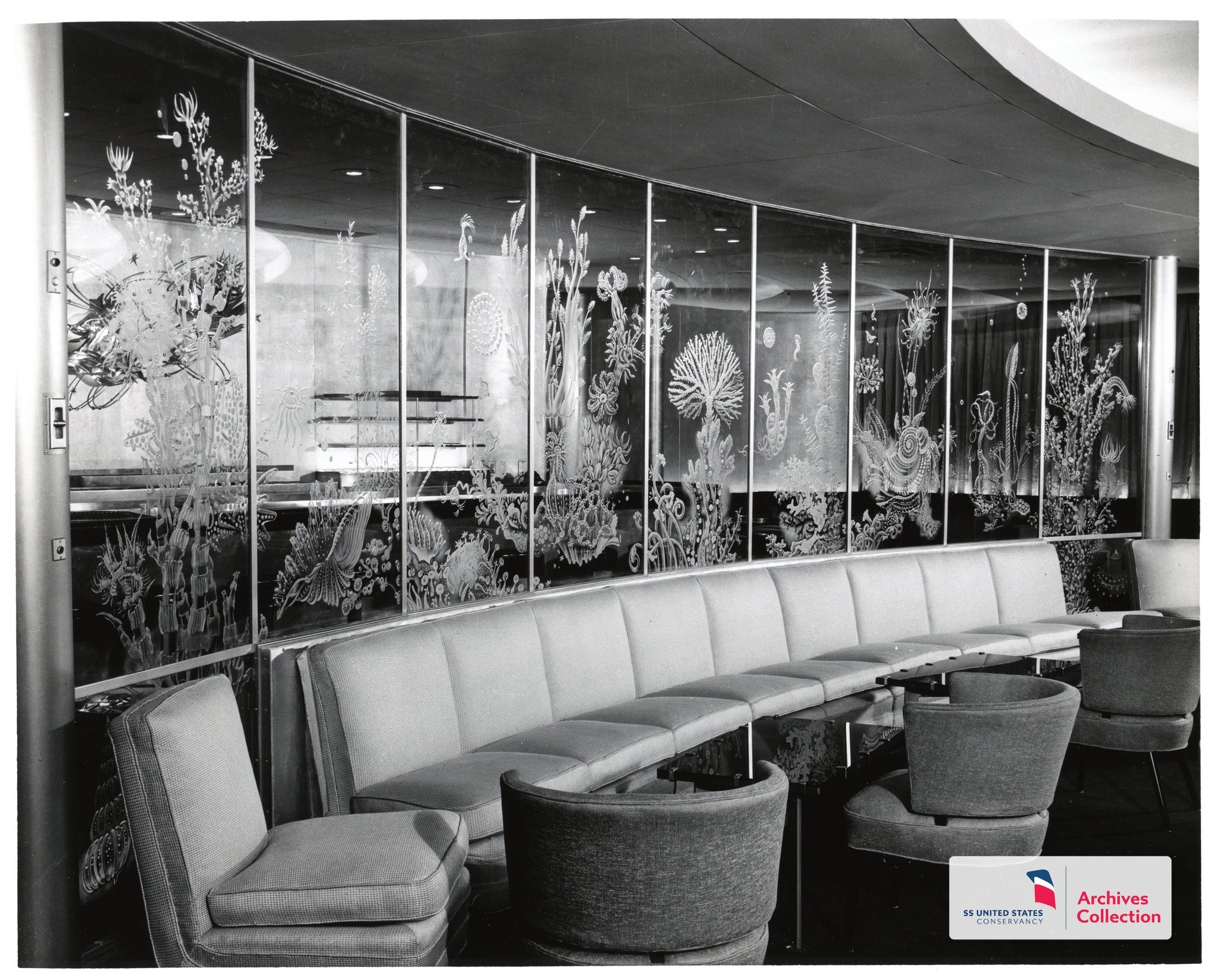The First Class Ballroom
The Ballroom was the social epicenter of the ship, with indirect lighting in a ceiling dome that cast a soft glow on exquisite panels of carved glass murals depicting undersea flora and fauna. These panels, made by Charles Gilbert of Texas, used sandblasting; the first time this medium had been adapted for fine art. The carved panels were shot through with top and bottom edge-lighting, that brought out the brilliant prismatic textures. The murals portrayed a complex and delightful undersea theme, with sea flowers, corals, and shells in a sea garden. Amidst them was an ingeniously camouflaged mermaid.
Accents of gold leaf were applied to the carved areas to enrich the decorative effect and blended with the pale gold frames. Elsewhere, pale gold leaf walls enhanced the room’s deep red and creamy white appointments, while glass top tables, an oval dance floor, and music by the Meyer Davis Orchestra all made for memorable evenings at sea. There was a total of nineteen of these panels and most of these panels now reside in storage at the Mariners’ Museum in Newport News, Virginia. A large number of these chairs can still be found scattered throughout the Hampton Roads area in private hands. The famous and fire resistant baby grand piano is now part of the Conservancy’s collection and is stored at the Steinway Hall Museum in Manhattan.
The bar that currently stands in the middle of the room isn’t original to ship. It’s a leftover movie prop from the 2013 Colin Farrell film Dead Man Down.
The First Class Restaurant
On the port side aft of the Ballroom was the First Class Restaurant. This intimate, dark-blue colored restaurant with seating for about 50 people, was decorated by Charles Lin Tissot. In his decorative panels, he used glass in a way it had never been used before and which presented unusual problems in execution and installation. Here the setting of his cut glass rods into stylized star-ray patterns, embedded in aluminum panels, had to be done with jeweler's precision. The panels were lighted from behind with great artistry to bring out the subtleties of the cutting, which is applied to the backs of glass rods and was magnified and distorted interestingly by the smooth rounded front surface. The glass ornaments themselves range from three inches to three feet in size to give an illusion of celestial distances. The portside windows look out onto the Promenade Deck and the sea. Food was brought up from the Main Galley on A Deck using dumbwaiters in the Pantry. Today, the ceiling of the curved entrance to the restaurant has the last vestiges of interior paneling still in place. This can be seen in the background of the picture left, to the right of the panel on the forward bulkhead (see arrow). Several of these panels also reside at Mariners’ Museum in Newport News, Virginia, with the largest panel in the ownership of the Conservancy and stored safely at Gibbs & Cox.
The First Class Navajo Lounge
On the starboard side aft of the Ballroom was the Navajo Lounge. This cocktail lounge was decorated with authentic reproductions of ritual sand paintings of the Navajo Indians. Created by Peter Ostuni, these versions were done in the permanent medium of vitreous enamel on copper. The Navajos created these for medicinal, magical, religious, rain-making and other rites and destroyed them by nightfall. Ostuni adapted the Indian method which was to make a floor of sand and dribble delicate patters on this with dry pigments. Ostuni, however, first cut each of his symbolic figures out of copper to fit a specific area of sand coated aluminum. The colors were then fused into the copper either with an acetylene torch or by firing in a kiln. Ostuni's beautiful symbolic murals were assembled tediously from hundreds of separate pieces. An Ostuni original design inspired by the sand paintings occupied the central wall. The four oversized portholes looking out on the Promenade Deck and the sea are a unique feature of this room. One of these panels now resides in storage at the Mariners’ Museum in Newport News, Virginia.





